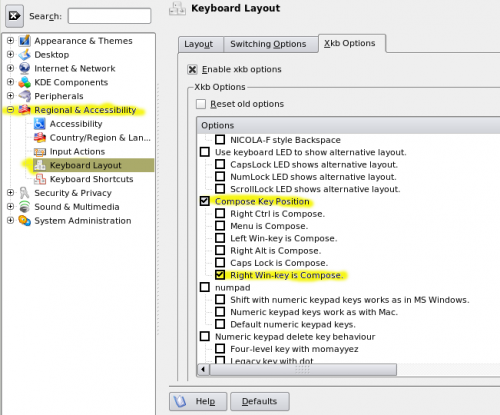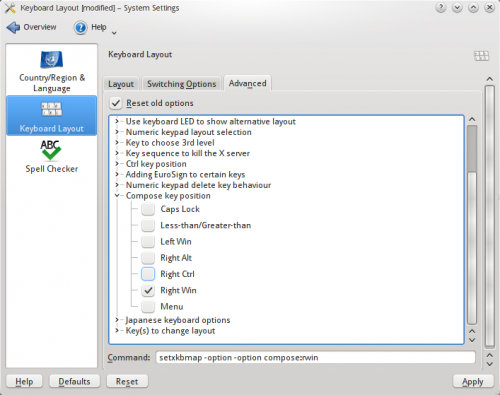Vejledning/ComposeKey
Brug og konfiguration af Composetasten
=Introduktion
Composetasten bruges til at skrive tegn, som normalt ikke er tilgængelige fra tastaturet; det kan for eksempel være bogstaver med omlyd, macron eller accenttegn.
Beskrivelsen her er blevet testet på flere Kubuntu Hardy Heron 8.04.1 systemer. Yderligere information kan findes i afsnittet Links og yderligere information nedenfor.
Modifikationerne vil virke med (næsten) alle applikationer, herunder skrivebordsmiljøet, browsere, OpenOffice.org samt mange kommandolinjeapplikationer.
De følgende instruktioner vil konfigurere en <compose> tast, som vil bruge <højre logo> tasten (på de fleste tastaturer er det et Windows logo).
Konfiguration af konsollen
For at gøre dette ordentligt prøver jeg at gøre det på "holistsk vis" og starte med konsollen:
- Genkonfigurér konsollen til det anvendte tastatur og tegnkodning. Gør dette i en tekstterminal eller konsollen.
$ sudo dpkg-reconfigure console-setup
- Følg disse skridt i konfigurationen:
- Vælg dit tastatur (her et standard 104 US tastatur)
- Hvis du ønsker !AltGr-tast-erstatningen, så vælg en
- Vælg, hvilken tast du ønsker at bruge som composetast. Jeg bruger højre logo-tast.
Jeg ville hellere bruge den venstre logo-tast, men det er ikke muligt i konsolindstillingerne. Det er dog muligt i den grafiske brugerflade (KDE Plasma).
- Vælg konsollens tegnkodning, sæt den til UTF-8
- Vælg, hvilke tegnsæt du vil have tilgængelige i konsollen. Jeg brugte Combined - Latin; Slavic Cyrillic; Hebrew; basic Arabic
Dette udvalg burde indeholde alle de tegn, jeg skal bruge.
- Vælg, hvilken type konsol-output du ønsker (gør lige hvad du vil; for at være på den sikre sikre side kan du vælge de aktuelle standarder)
- En ny initial RAM-disk til den næste opstart bliver nu dannet.
Konfiguration i KDE 3.x
Nu kan vi gå videre og konfigurere den grafiske brugerflade. Denne beskrivelse bruger enten KControl eller Kubuntus konfigurationsværktøj, som har de samme dialoger.
- Start Systemindstillinger eller KDE Kontrolcenter
- (i Systemindstillinger) eller (for Kontrolcenter) ->
- Vælg dit tastaturlayout
- Modificér ved at aktivere composetasten.

KDE SC 4.x configuration
Now we can go on and configure our windowing environment (Plasma). This description uses the System Settings as they're available in the K-Menu of the Kubuntu install:
- Start the System Settings
- Select the <menuchoice>Keyboard Layout configuration
- Under the Layout tab, select
- Modify Advanced options to select/enable the compose key

Configuration for Gtk Applications (Gnome, FireFox, etc.)
Gtk (such as also FireFox) and Gnome applications use (on an Ubuntu system) usually SCIM as the input method, not XIM (X Input Method) that relies on the configurations from (X)Compose. Therefore, you will often find that the "a" and "o" macron characters can yield the female/male ordinals "ª" and "º". To still make it work, Gtk applications need to be "told" to use XIM instead.
"One Off" Configuration
For a single application you can do it by just setting the environment variable GTK_IM_MODULE for the application to be launched to xim:
$ GTK_IM_MODULE=xim firefox
More permanently that can be done for a single shell session like this:
$ export GTK_IM_MODULE=xim
This can, of course, also be persisted for a single user in your ~/.bash_profile, or for all users in /etc/environment. This is, however, the less elegant way, the more elegant way follows below.
Persistent Configuration
- Copy the setup file /etc/X11/xinit/xinput.d/default to /etc/X11/xinit/xinput.d/xim
$ sudo cp /etc/X11/xinit/xinput.d/default /etc/X11/xinit/xinput.d/xim
- Edit the file /etc/X11/xinit/xinput.d/xim and set the input method for GNOME and KDE to xim
... GTK_IM_MODULE=xim QT_IM_MODULE=xim ...
- Create a link for the locale all_ALL (or the desired locale only):
$ sudo ln -sf /etc/X11/xinit/xinput.d/xim /etc/X11/xinit/xinput.d/all_ALL
If you are using a Debian-derived distribution use following instead
$ sudo update-alternatives --verbose --install /etc/X11/xinit/xinput.d/all_ALL xinput-all_ALL /etc/X11/xinit/xinput.d/xim 20
- After a restart of the X server everything should work.
Optional Tweaking of XCompose Map
Now that you're using XIM, you can further tweak the XCompose input map for further characters, or for characters in more convenient locations, etc.
To do that follow these steps:
- Create a ~/.XCompose file, and put the following lines into it:
# ~/.XCompose # This file defines custom Compose sequences for Unicode characters
# Import default rules from the system Compose file: include "/usr/share/X11/locale/en_US.UTF-8/Compose"
# To put some stuff onto compose key strokes: <Multi_key> <minus> <greater> : "→" U2192 # Compose - > <Multi_key> <colon> <parenright> : "☺" U263A # Compose : ) <Multi_key> <h> <n> <k> : "hugs and kisses" # Compose h n k <Multi_key> <less> < p> : "< p>" # Compose < p
- Just log out and in again (no restart necessary), and you can use your new "multi key short strokes" using the compose key to your desire. As you see this even works for creating longer character sequences.
Typing Macrons, Umlauts, Accents, ...
The compose key will be now whatever you have configured it to be, e. g. right logo.
- Macrons
compose + shift + hyphen then <vowel >or
compose + underscore then <vowel >-->
āēīōū ĀĒĪŌŪ
- Umlauts
compose + shift + <single quote> then <vowel >or
compose + <double quotes> then <vowel >-->
äëïöü ÄËÏÖÜ
- The German Ess-Zet ligature
compose then s and s (twice the "s")
-->
ß
- More bindings can be found in /usr/share/X11/locale/en_US.UTF-8/Compose
Links og yderligere information
- http://cyberborean.wordpress.com/2008/01/06/compose-key-magic/
- http://ubuntuforums.org/showthread.php?t=209115
- http://www.seedwiki.com/wiki/takomapark/compose2
- http://wiki.linuxquestions.org/wiki/Accented_Characters
- http://people.uleth.ca/~daniel.odonnell/Blog/custom-keyboard-in-linuxx11
- http://hdante.blogspot.com/2007/05/kiel-oni-skribas-typing-esperanto.html
